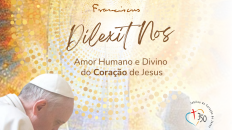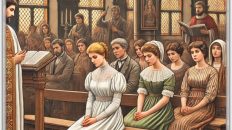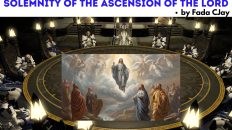May 13, 2017 – I OPENED MY BIBLE AND DISCOVERED THE ROSARY PRAYERS
On this day, May 13, 2017 (100 years anniversary of the Apparition of Mary at Fatima, in which the blessed Virgin requested a daily recitation of the rosary), I present this article for the critics of the rosary prayers; those who have perennially questioned the scriptural foundation of the rosary and rendering it manmade. In the same vein, I dedicate this article to Our Lady of Fatima whose feast we celebrate today.
Concisely, the rosary is made up of “The Lord’s prayer (Our Father), “Hail Mary…” (Angelic greeting) and the summary of the childhood, ministry, suffering, and death of Christ, and also the important role played by Mary in the salvation history. Here it is below:
- The “Our Father” (The Lord’s prayer) – is literally biblical: Matt. 6:5-13
- The first part “Hail Mary, full of grace, the Lord is with you” corresponds to the Angel’s salutation at the Annunciation (Lk. 1:28). Consequently, the phrase: “Blessed art thou amongst women, and blessed is the fruit of your womb (Jesus)” is exactly the expression of Elizabeth, wife of Zachariah, by the influence of the Holy Spirit – we were told, Elizabeth was filled with the Holy Spirit immediately she heard Mary’s greetings (Lk. 1:40-42) .
- The second part of the rosary prayer, “Holy Mary, Mother of God, pray for us sinners, now and at the hour of our death”, might be understood as follows:
(i) “Holy Mary” again corresponds to the biblical passage of the Annunciation “full of grace”. Some versions of the bible indicate “highly favoured daughter”. Now let us turn to the Greek version of the bible (the original language in which the New Testament Bible was written). In the Greek version of the bible, we see “Kecharitomene” in Lk 1:28. With a rudimentary knowledge of Biblical Greek, I’ve come to understand that KECHARITOMENE is a PERFECT PASSIVE PARTICIPLE of the verb “CHARITOO”. This means “to fill or endow with grace.” Now, those who have studied the English language would understand what a perfect passive participle means. This is how it is interpreted: it indicates that Mary was graced in the past and with continuing effects in the present, and so will it be in the future. Therefore, the grace Mary enjoyed was not a result of the angel’s visit. In fact, we Roman Catholics hold that it extends over the whole of her life, from the very moment of her conception onwards (That is how we arrive at the doctrine of the Immaculate conception). Therefore, She was in a state of sanctifying grace from the first moment of her existence, that is why we call her Holy Mary. Likewise, Jesus also was referred to as “Full of Grace…” in John 1:14. These were the only two figures in the entire scripture referred to as “full of grace” – without sin.
(ii) The expression “Mother of God” refers to the fact that the fruit of her womb (Jesus) is also God (True man and True God {the God-Man} – Theoanthropos). Hence, Mary did not give birth to a Jesus who is only a man, but gave birth to Jesus, True God, and True Man). Little wonder Elizabeth who was filled with the Holy Spirit added to her expression: “Why should I be honoured with a visit from the MOTHER OF MY LORD” (Lk. 1:43)
(iii) The phrase “Pray for us” can be referred to as the intercessory role of Mary and it can be related to the Wedding Feast at Cana where Mary intercedes with her Son for the couple who ran out of wine. (John 2:5). In other words, Jesus’ first sign was prompted by his mother. Hence, we implore her intercession till the hour of our death because we are sinners.
(iv) Finally, the doxology “Glory be to the Father” makes direct reference to the Trinity; Father, Son and Spirit and the praise due to them.
THE MYSTERIES OF THE ROSARY
As stated earlier, the rosary is the summary of the childhood, ministry, suffering, death and resurrection of Christ, and also the important role played by Mary in the salvation history. We have the following mysteries: Joyful, Luminous, sorrowful, and Glorious.
- JOYFUL MYSTERIES: (i) The Annunciation – Luke 1: 26-38; John 1:14. (ii) The Visitation – Luke 1: 39-56. (iii) The Nativity of Christ – Luke 2: 6-20. (iv) The Presentation of Jesus in the temple – Luke 2: 22-39. (v) The Finding of the Child Jesus in the Temple – Luke 2: 41-51
- LUMINOUS MYSTERIES: (i) The Baptism of Jesus – Matthew 3:11-17; Luke 3:15-22; John 1:22-34. (ii) The manifestation of Jesus at the Wedding Feast at Cana – John 2: 1-12. (iii) The Proclamation of the Kingdom and call to Conversion – Mark 1:14-15; Matthew 5:1-8; Matthew 6:33; Matthew 7:21. (iv) The Transfiguration of Jesus – Luke 9:28-36; Matthew 17:1-8. (v) The Institution of the Eucharist – Matthew 26:26-28; John 6: 33-59 *Note: The five Luminous Mysteries, or Mysteries of Light, were introduced in 2002 by Pope John Paul II.
- SORROWFUL MYSTERIES: (i) The Agony of Christ in the Garden – Matthew 26: 36-46; Mark 14:32-42; Luke 22: 39-46. (ii) The Scourging of Christ at the Pillar – Matthew 27:26; Mark 15:15; John 19:1. (iii) The Crowning with Thorns – Matthew 27:29-30; Mark 15:16-20; John 1: 2-3. (iv) The Carrying of the Cross – Luke 23: 26-32; Matthew 27:31-32; Mark 15:21; Luke 23: 26-32. (v) The Crucifixion of Christ – Luke 23: 33-46; Matthew 27: 33-54; Mark 15: 22-39; Luke 23: 33-47; John 19: 17-37
- GLORIOUS MYSTERIES: (i) The Resurrection of Christ – Matthew 28: 1-10; Mark 16: 1-18; Luke 24: 1-49; John 20:1-29. (ii) The Ascension into heaven – Mark: 16: 19-20; Luke 24: 50-51; Acts 1: 6-11 (iii) The Descent of the Holy Spirit – Acts 2: 1-41 (iv) The Assumption Revelation 12:1. (v) Coronation of Mary, Queen of Heaven and Earth Revelation 12:1.
* Mary‘s Assumption and Coronation are implied in Revelation Chapter 12 and in other Biblical references, but neither is directly stated in the Bible. Both events are part of Catholic Tradition. The Catechism of the Catholic Church defines the Assumption in Sections 966 and 974.
From what we have seen so far, one cannot deny but conclude that the rosary prayers said by Catholics is indeed, the summary of the New Testament. Put differently, it is just like reading the Bible (the New Testament). Little wonder the Blessed Virgin appeared to the three children at Fatima (on this day, 100 years ago) and urged a daily recitation of the rosary, which she gave to Saint Dominic in the year 1214.
Therefore, we pray that as we recite the rosary daily, may its fruits continue to enrich and sanctify our souls. Amen.




